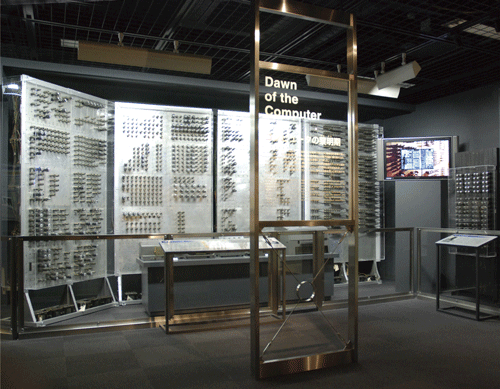

- Home >
- Artifacts of IP Heritage >
- 2008 >
- Osaka University Vacuum Tube Computer
Osaka University Vacuum Tube Computer

| Manufactured in | 1950s |
|---|---|
| Manufactured by | Prof. Jo Kenzo's Laboratory, Faculty of Engineering, Osaka University |
| Owner | Osaka University |
| Location of historical materials | Machikaneyama School, The Museum of Osaka University, 1-20 Machikaneyama-cho, Toyonaka-shi, Osaka 560-0043 Japan |
| Visitor information | Open to the public |
| Contact | Machikaneyama School, The Museum of Osaka University Tel.+81-6-6850-6284 https://www.museum.osaka-u.ac.jp/ |
Joh Kenzo, professor of the Faculty of Engineering of Osaka University, researched on calculating machines during World War II. As soon as he learned the first computer ENIAC was completed in the United States in 1946, he began to research on an electronic digital computer. He, together with Makinouchi Saburo and Yasui Hiroshi, built a prototype of a decimal arithmetic unit based on the ENIAC circuits in 1950 and experimented in its operation.
Jo then started the development of Osaka University vacuum tube computer, a binary stored program machine based on EDSAC instruction sets. It used 1,500 vacuum tubes and 4,000 diodes. The clock frequency of this machine was 1MHz (the clock frequency of EDSAC was 500kHz) and addition/subtraction time 40milli seconds. As memory elements, the machine used 32 glass solid delay line elements with a each memory capacity of 32 words developed by the Electrotechnical Laboratory. Due to issues like an inadequate budget and personnel, it took a long time to purchase parts, and fabricate and adjust the machine.
At the final stage of adjusting the entire computer, the university decided to introduce a Japanese commercial computer, so overall finishing of the Osaka University vacuum tube computer was suspended. As the development of an digital electronic computer at Osaka University was one of the earliest project in Japan, it was paid attention to by many organizations and contributed to promote the later computer development in Japan.
Type Arithmetic System was prototyped in 1950 by Joh Kenzo and others at Osaka University. The system was designed and prototyped in 1950 by Joh Kenzo, Makinouchi Saburo and Yasui Hiroshi of the Faculty of Engineering of Osaka University , based on references explaining the mechanism of the ENIAC's arithmetic unit. This was done with the aim of conducting follow-up experiments on the arithmetic unit of the first electronic computer, the ENIAC, which was announced in the United States in 1946. This was a 4 digit decimal arithmetic unit based on vacuum.
